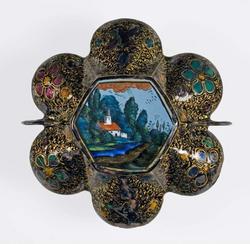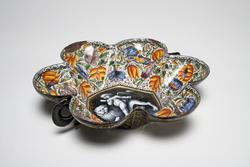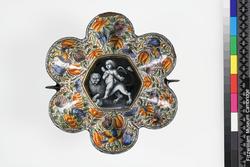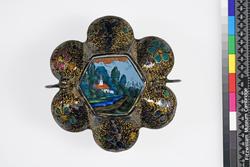Current Location: Gallery 32 (Rothschild)
Maker(s)
Maker:
Laudin, Jacques I
Entities
Categories
Description
Copper decorated en grisaille and polychrome enamels and gilded. Cupid riding on a lion with the inscription 'omnia vinci amor (Love conquers all) and signed '‘•I•L•’; on the sides floral sprays and birds; and on the back a central landscape, surrounded by stylized floral sprays.
Copper, raised, and decorated in three techniques: enamelling in grisaille on a black ground and gilded; enamelling in blue, green, yellow, orange-red, pale manganese/mulberry, and black on a white ground; and enamelling in blue, turquoise, green, yellow, and mulberry translucent enamels over silver foils in a black ground, and gilded. The hexafoil bowl has lobed sides rising from a slightly convex hexagonal base, and two small S-shaped handles on opposing sides In the middle, framed by two gold lines is a hexagonal panel executed in grisaille on a black ground of Cupid riding on a lion walking to the left. Cupid has a quiver of gold arrows slung on his back by a gold strap, and controls the lion by means of a gold leash passing through its mouth. The lion has gold toe nails and some of Cupid’s wavy hair is gold. On the left edge ‘omnia uinci amor’(Love conquers all) is inscribed in gold The initials ‘•I•L•’ in black are inscribed in front of the lion’s left rear paw. The sides have a white ground decorated with blue, pale mulberry, and red and yellow flowers on black stems with green foliage, amongst which, on three lobes, there is a fanciful bird. Round the rim is a border of black petals with vertically striated semi-circular centres.
On the hexagonal base framed by black and gold lines there is a landscape in which is a white house with a red roof beside a stream, with a clump of trees behind it. Four small flocks of birds fly through the opaque pale blue sky. The black sides are decorated with stylized flowers and gold foliage, amongst which, on two lobes, is a fanciful bird in translucent enamels over silver foils. The handles are black with remnants of a gold line following its S-shape.
Notes
History note: Unknown before Frank McClean, MA, FRS (1837-1904), Rusthall House, near Tunbridge Wells
Legal notes
Frank McClean Bequest
Measurements and weight
Height: 3.7 cm
Width: 15.5 cm
Acquisition and important dates
Method of acquisition: Bequeathed
(1904)
by
McClean, Frank
Dating
17th Century, second half
Louis XIV (1638-1715)
Circa
1650
CE
-
1695
CE
Note
Small enamelled two-handled bowls or cups with hexafoil or circular rims became fashionable in the mid 17th century and large numbers of them have survived. Most of them are decorated on the base with a landscape, surrounded by stylized flowers and birds in translucent enamels over foils in a black ground embellished with gold foliage. Others have floral decoration on a white ground. The central medallion inside may be of a religious, classical, or other secular subjects, and the interior sides are usually decorated with polychrome flowers and birds on a white ground in either a continuous band or in panels. Many of them bear the initials ‘.I.L.’ and these have usually been attributed to Jacques Laudin I (c. 1627-95), for example by Darcel and Marquet de Vasselot, although it is possible that some of them were executed by his nephew Jacques II Laudin (c. 1663-1729). However, the decoration of the reverse of the Fitzwilliam’s bowl, resembles that on other pieces attributed to Jacques I Laudin.
Cupid riding a lion, emblematic of the power of Love, accompanied by the inscription ‘omnia vincit amor’ from Virgil’s Eclogues, X, 69: ‘omnia vincit Amor: et nos cedamus Amori.’ (Love conquers all; let us, too, yield to Love’) was a popular one in the 17th century. A a circular image appeared with a fiercer lion, as the first plate in the earliest Dutch emblem book by Daniël Heinsius, published untitled in 1601 but known as Quaeris quid sit amor? and titled, Emblemata amatoria, in the second edition of 1611.
The emblem occurs on four more hexafoil bowls: in the Fitzwilliam (M.3-1928), the Musée des Beaux-Arts, Limoges (101); and the Musée d’Art et d’Archéologie, Guéret (2009.0.335), and one unlocated, sold in Paris in 2004. Four more with circular rims are respectively in the the Ashmolean Museum (OA 248), the Victoria and Albert Museum (C.23-1923), the Musée des Beaux-Arts, Limoges (94), and the Musée des Beaux-Arts, Dijon (CA T 1322). The shape of another, formerly in the Königliche Kunstkammer Berlin, (Inv. I.G.179), but now lost is not certain, but may have been of hexafoil form as it was not described as having a footring. Several others were mentioned in 19th century French and English sales.
People, subjects and objects depicted
Components of the work
Decoration
composed of
enamel
( opaque blue, green, yellow, orange-red, pale mulberry, white, and black)
enamel
( translucent turquoise, green, yellow, and mulberry)
silver foil
gold
Materials used in production
Copper
Techniques used in production
Raising (metal forming process)
: Copper, raised, enamelled in grisaille on a black ground and gilded; painted in blue, green, yellow, orange-red, pale manganese/mulberry, and black enamels on a white ground; and enamelled in blue, turquoise, green, yellow, and mulberry translucent enamels over silver foils reserved in a black ground, and gilded.
Inscription or legends present
- Text: omnia uinci amor
- Location: Inside in centre
- Method of creation: Painted in gold
- Type: Inscription
- Text: •I•L•
- Location: Inside in front of the lion’s left rear paw.
- Method of creation: Painted in black
- Type: Initials
References and bibliographic entries
-
Fitzwilliam Museum, McClean Bequest, Catalogue of the Mediaeval Ivories, Enamels, Jewellery, Gems and Miscellaneous Objects Bequeathed to the Museum by Frank McClean, M.A., F.R.S.
page(s): 114
-
Le métier d’émailleur à Limoges, XVIe-XVIIe siècle
page(s): 386, 388
-
Catalogue descriptif des objets d’art formant le musée Anthelme et Edma Trimolet
-
Catalogue of the Valuable Collection of Pictures, Works of Art, and Decorative Objects of Christopher Beckett Denison, Esq., Deceased, late of Upper Grosvenor Street, First Portion
page(s): 77
-
Guide du Musée Municipal, Collection Égyptienne, Émaux
page(s): 75
-
Maleremails aus Limoges, Der Bestand des Berliner Kunstgewerbemuseums
page(s): 158
-
Les émaux peints de Limoges. Musée du Louvre, Département des objets d'art
-
Maleremails des 16. und 17. Jahrhunderts aus Limoges, Herzog Anton Ulrich-Museum Braunschweig, Kunstmuseum des Landes Niedersachsen
page(s): 87, 263-4
-
Smalti-Avori del Museo d'Arte Antica
page(s): 111-12
Identification numbers
Accession number: M.51-1904
Primary reference Number: 139844
Stable URI
Audit data
Created: Saturday 6 August 2011
Updated: Tuesday 30 April 2024
Last processed: Thursday 14 August 2025
Associated departments & institutions
Owner or interested party:
The Fitzwilliam Museum
Associated department:
Applied Arts
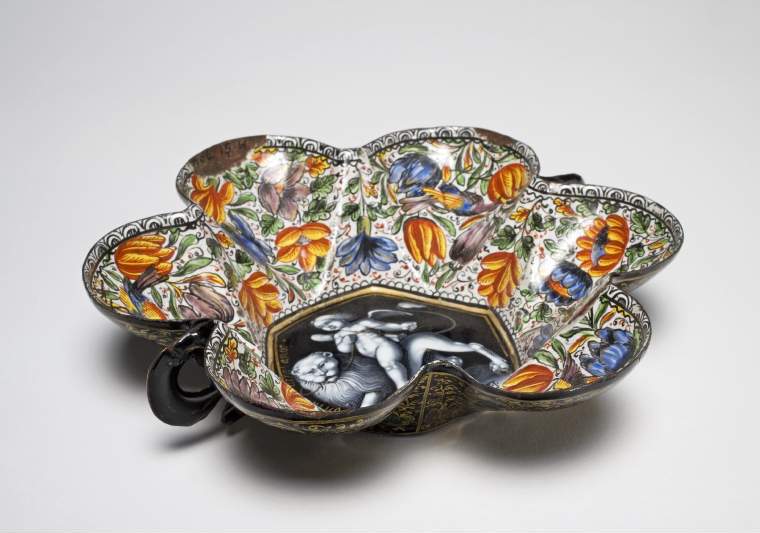
 IIIF Manifest
IIIF Manifest

